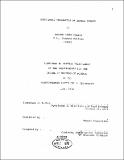Functional properties of banana starch
Author(s)
Carson, Eunice Marks
DownloadFull printable version (3.438Mb)
Other Contributors
Massachusetts Institute of Technology. Dept. of Nutrition and Food Science.
Advisor
James K. Palmer.
Terms of use
Metadata
Show full item recordAbstract
The functional properties (ease of cooking, thickening power, paste stability, etc.) of banana starch have been deduced by comparison of the cooking and cooling curves (obtained on the Brabender Amylograph) of banana, corn, tapioca, waxy maize and cross-bonded waxy maize starches. Banana starch has functional properties generally similar to cross-bonded waxy maize, except that banana starch pastes tend to cook more slowly and are much less resistant to breakdown under acid conditions. The -three banana starch samples examined were mixtures of small and large grains, plus some agglomerates. One sample was fractionated by a simple, air classification method. The smaller grains (25% of total by weight; 22 + 7 microns in the greatest dimension) and the larger grains 50%; 39 + 10 microns in the greatest dimension) had functional properties almost identical to that of the whole starch. The agglomerates (15%; clumps and fragments of wide size variation) had similar functional properties, but with reduced thickening power. About 10% of the starch was lost during classification. Banana "flour" (dried and finely ground, green banana pulp) contained 70%.starch and had functional properties remarkably similar to the isolated banana starch. This "flour" could possibly be substituted for isolated starch at considerable savings. Potential food uses for banana starch and banana "flour" are discussed, as well as the possible molecular basis for the unique properties of the banana starch.
Description
Thesis (M.S.)--Massachusetts Institute of Technology, Dept. of Nutrition and Food Science, 1972. "June 1972." Vita. Includes bibliographical references (leaves 55-56).
Date issued
1972Department
Massachusetts Institute of Technology. Department of Nutrition and Food SciencePublisher
Massachusetts Institute of Technology
Keywords
Nutrition and Food Science.